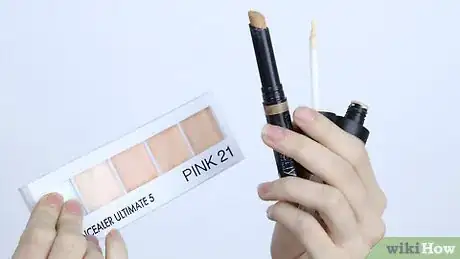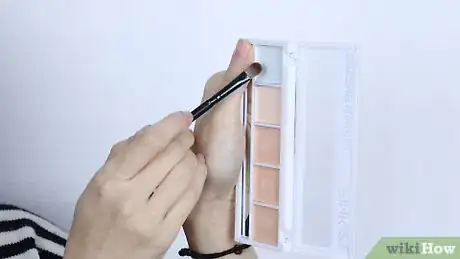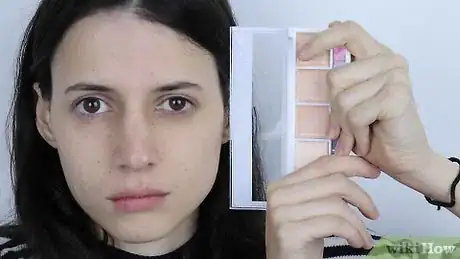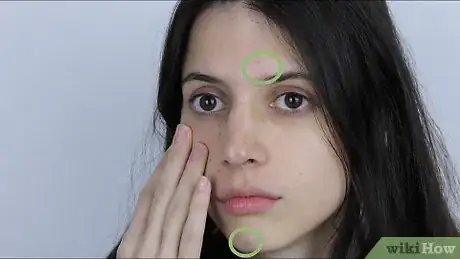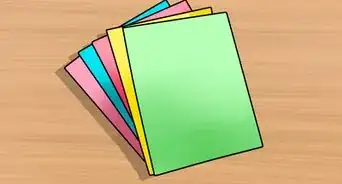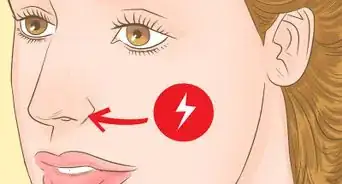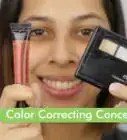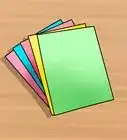This article was co-authored by Devorah Kuperland. Devorah Kuperland is a Makeup Artist and the Founder of Glam By Dev, a New York City-based business specializing in bridal, special events, and editorial campaigns. Devorah has over five years of professional makeup consulting experience and her work has been featured in New York's Bridal Fashion Week.
There are 13 references cited in this article, which can be found at the bottom of the page.
This article has been viewed 60,237 times.
Using the right type and shade of concealer correctly will help you achieve a flawless complexion. Concealer is mostly commonly used to cover dark under eye circles. However, it may also be used to cover up blemishes, dark spots, scars, and varicose veins.
Steps
Selecting the Right Concealer and Tools
-
1Choose the right type of concealer. Concealers come in many forms and sizes. Each of the 6 types of concealers is formulated for specific skin types and coverage. It is common to use more than one kind of concealer at a time.[1] Selecting the correct concealers for your skin type and problem areas will guarantee optimal coverage.
- Stick concealers come in tubes similar to lipstick and are used to provide full to medium coverage for dark eye circles.[2] These thick, creamy concealers are ideal for the individual with normal, dry, or sensitive skin. Stick concealers go on thick and often contain oil so the user can easily spread and blend the makeup. Therefore, avoid stick concealers if you have oily skin.[3]
- Cream concealers come in a small pot, compact, or palette. This medium to full coverage concealer is ideal for the individual with normal, extremely dry, combination, or sensitive skin. Its thick texture provides wonderful coverage for individuals with extreme discoloration.[4] If not blended and set properly, this concealer can sit very heavy on your skin.[5]
- Cream-to-powder concealers come in compacts. This light to medium concealer is ideal if you have normal, semi-dry, combination, or sensitive skin. Cream-to-powder concealers are designed for use anywhere on the face.[6] However, you should never use this concealer to cover a blemish or patches of dry, flaky skin. The oils and ingredients found in these products tend to make breakouts worse and emphasize dry skin.[7]
- Creamy liquid concealers come in small squeezable tubes or tubes with wand applicator. This type of concealer is formulated to provide light to full, even under eye coverage. It is ideal for individuals with normal, combination, oily, or sensitive skin. It also provides excellent coverage for blemish-prone skin.[8] Unlike stick concealers, creamy liquid concealers are less likely to crease. Their light formula allows for buildable coverage.[9]
- Matte-finish liquid concealers come in small squeezable tubes or tubes with wand applicator. This type of concealer provides light to full coverage. Matte-finish liquid concealers are ideal for covering blemishes. You may also use them as the base for your eyeshadow. It does not crease or slip; it also outlasts cream and powder concealers.[10]
-
2Select a color-correcting concealer to combat specific problems. Color-correcting concealers are available in liquid, cream, or stick form. When flesh-toned concealers fail to provide adequate coverage, use a color correcting concealer. To mask the concealer’s hue, first apply your color-correcting concealer, followed by your foundation, and a layer of flesh-toned concealer. The 5 colors offer solutions for 5 distinct problems:
- Lavender is used to conceal sallow or yellow-toned skin.
- Yellow conceals deep purple tones, such as under eye circles or scars.
- Green conceals redness.
- Pink conceals the bluish hint that commonly accompanies lighter skin tones.
- Orange or salmon conceals blue, gray, and purple blemishes or undereye circles.[11]
Advertisement -
3Match the concealer to your skin tone for general coverage. Applying a concealer that is too light or too dark counteracts the product’s purpose. It will only draw attention to your problem areas. To ensure that you select the right shade, test the product in the store. Swipe or dab a small amount of concealer onto your jawline. After blending in the product, examine the results. If the product is visible on your face it is either too light or too dark. If you can not see the product, you have selected the right shade.[12]
- Try to match the shade of your general coverage concealer to the shade of your foundation. This will result in a flawless, well blended look.[13]
- An exception to this rule pertains to the concealer you will use under your eyes or to cover dark spots. Concealer used for these purposes should be 1 to 2 shades lighter than your foundation and general coverage concealer. This will highlight and lighten the dark area.[14]
-
4
Preparing Your Face for Concealer
-
1Wash your face. Before applying moisturizer and makeup, always thoroughly clean your face to remove dirt, oil, and makeup. Use eye makeup remover to wipe off mascara, eyeshadow, and eyeliner. Douse a cotton pad with cleansing water. Gently wipe your face with the saturated cotton pad to remove makeup.[17]
-
2Determine your desired level of coverage. The level of coverage you require will vary from day to day. After cleansing your face, observe your skin in the mirror. Note the areas of your face you would like to conceal. Gather the tools and makeup required to conceal these problem areas.
- Do you have dark circles under your eyes?
- Is the area around your nose red?
- Do you have a zit or a breakout?
- Are there any scars or patches of discoloration visible?
-
3Moisturize your face. Face lotion combat dryness and the sun’s rays throughout the day. Squirt, scoop, or dab a small amount of face lotion into your hands. Warm-up the moisturizer by rubbing it between your fingers. Apply a light, even layer over your face.
- If your skin is oily, use a gel based moisturizer.[18]
-
4Moisturize under your eyes. The area under your eyes is very delicate and prone to dryness. Eye creams provide extra protection and moisture to this area. Use the pads of your fingers to dab a small amount of eye cream under each eye. Carefully rub in the cream and allow it to dry.[19]
-
5Apply primer. Primer helps your concealer and foundation stick to your skin and stay in place. Choose a primer designed for your skin type. Apply it using clean fingers, and focus on your T-zone (such as your chin, nose, eyelids, and forehead).[20]
- If your skin is really oily, you can apply primer to your entire face.
Applying Concealer
-
1Conceal dark eye circles. Concealers’ most common application is under the eyes. Instead of drawing a semicircle under the eyes, create a triangle. The triangle method, which you may apply with your fingers, a brush, a wand, or a sponge, will highlight and lift your face.
- Try using a lighter-colored concealer to highlight the area
under your eyes.[21]
-
1
- Begin at the inner corner of your left eye. Draw or dab a diagonal line of concealer from the inner corner to the top center of your cheekbone. From the top center of your cheekbone, draw a diagonal line up to the outer corner of your eye. Use your tool of choice to lightly blend the concealer down and outwards. Avoid pulling or rubbing on the skin under your eye.
-
2Cover-up scars and dark spots. Use a cream concealer and concealer brush to mask scars and dark spots. Dip the brush into the full coverage cream concealer. Use the brush to dab the concealer directly onto the dark spot or scar. Apply one layer of highlighting concealer. Dab the area with a damp sponge to blend the makeup.[22]
- Less is more when it comes to concealer. Try to find almost the exact same shade as your skin, and dab a very small amount onto the spot you're trying to cover. Then, use a brush to blend the concealer around the spot to blend it. However, avoid putting your brush right on the spot, since that will just remove the makeup.[23]
-
3Conceal puffiness. Although it is not possible to cover puffy eyes, you can mask the puffiness with a concealer and highlighter. Combine a small amount of liquid concealer with a drop of highlighter. Use your fingers, a brush, or a sponge to dab the mixture onto the puffy area. Blend the makeup down and out.[24]
-
4Cover up redness. To conceal redness, use an oil-free cream concealer, a damp sponge, and loose powder. Use your fingers to dab the concealer onto the red areas. Blend the makeup by dabbing the area with a damp sponge that you’ve dipped in loose powder.[25]
-
5Conceal zits and blemishes. When concealing a zit or textured blemish, use a concealer pencil. With the point of the pencil, go over and around the zit or blemish. Dab the area with a damp sponge, followed by a light coat of loose powder.
- If the zit or blemish is red, use a green concealer.[26]
-
6Conceal varicose veins. To conceal varicose veins, use a flesh-toned concealer pencil. After applying your foundation, trace over the varicose veins with your concealer pencil. Use your fingers to blend in the makeup. Apply a second coat of foundation to further blend the makeup. Complete process by dabbing a damp sponge dipped in loose powder over the area.[27]
Blending and Setting Your Makeup
-
1Apply foundation. You may choose to apply your foundation at various points in the process. For full coverage, apply your foundation before you put on any concealer. For less coverage, or if you’re using a tinted concealer, apply your concealer before your foundation. Begin applying the foundation at the center of your face and blend out, up, and down.[28]
- Pour or squirt a quarter sized amount of liquid foundation onto the top of your non-dominant hand, or dip a natural hair foundation brush into the foundation.
- Foundation is different from concealer, because concealer is used to cover up smaller areas, like blemishes or the area under your eyes, whereas foundation is meant to be applied all over your face to even out your skin tone.[29]
-
2Blend your makeup. Blending is the key to a flawless look. Use a beauty blender to blur the lines between your foundation and your concealer, making it difficult to tell where one starts and the other begins.[30]
-
3Set your makeup. Setting your makeup with a loose translucent powder will combat shininess caused by oil. Dip a small natural hair powder brush into your loose translucent powder. Tap the brush on the side over the container to remove any excess powder. Gently sweep the brush between your eyebrows, down your nose, under your eyes, and around your chin.
Expert Q&A
-
QuestionCan you put concealer on pimples?
 Laura MartinLaura Martin is a Licensed Cosmetologist in Georgia. She has been a hair stylist since 2007 and a cosmetology teacher since 2013.
Laura MartinLaura Martin is a Licensed Cosmetologist in Georgia. She has been a hair stylist since 2007 and a cosmetology teacher since 2013.
Licensed Cosmetologist Yes, dab concealer on the pimple and gently pat to blend into surrounding area.
Yes, dab concealer on the pimple and gently pat to blend into surrounding area. -
QuestionWhat is the main purpose of concealer?
 Laura MartinLaura Martin is a Licensed Cosmetologist in Georgia. She has been a hair stylist since 2007 and a cosmetology teacher since 2013.
Laura MartinLaura Martin is a Licensed Cosmetologist in Georgia. She has been a hair stylist since 2007 and a cosmetology teacher since 2013.
Licensed Cosmetologist Concealer hides unwanted tones in the skin providing coverage for dark circles, scars, and blemishes.
Concealer hides unwanted tones in the skin providing coverage for dark circles, scars, and blemishes. -
QuestionHow does the age rewind concealer work?
 Laura MartinLaura Martin is a Licensed Cosmetologist in Georgia. She has been a hair stylist since 2007 and a cosmetology teacher since 2013.
Laura MartinLaura Martin is a Licensed Cosmetologist in Georgia. She has been a hair stylist since 2007 and a cosmetology teacher since 2013.
Licensed Cosmetologist Like other concealer formulas, it covers unwanted tones in the skin with a thick, heavily pigmented formula.
Like other concealer formulas, it covers unwanted tones in the skin with a thick, heavily pigmented formula.
Warnings
- Discard your concealer after 6 months, or sooner if the color changes or the product begins to smell.⧼thumbs_response⧽
References
- ↑ http://www.today.com/style/how-choose-right-concealer-1D80228045
- ↑ http://www.prevention.com/beauty/makeup-how/how-apply-concealer-and-foundation
- ↑ http://www.paulaschoice.com/expert-advice/eyes/_/how-to-choose-and-use-concealer
- ↑ http://www.paulaschoice.com/expert-advice/eyes/_/how-to-choose-and-use-concealer
- ↑ http://www.prevention.com/beauty/makeup-how/how-apply-concealer-and-foundation
- ↑ http://www.prevention.com/beauty/makeup-how/how-apply-concealer-and-foundation
- ↑ http://www.paulaschoice.com/expert-advice/eyes/_/how-to-choose-and-use-concealer
- ↑ http://www.paulaschoice.com/expert-advice/eyes/_/how-to-choose-and-use-concealer
- ↑ http://www.prevention.com/beauty/makeup-how/how-apply-concealer-and-foundation
- ↑ http://www.prevention.com/beauty/makeup-how/how-apply-concealer-and-foundation
- ↑ http://www.paulaschoice.com/expert-advice/eyes/_/how-to-choose-and-use-concealer
- ↑ http://www.youbeauty.com/beauty/how-to-choose-the-right-concealer/
- ↑ http://www.youbeauty.com/beauty/how-to-choose-the-right-concealer/
- ↑ http://www.prevention.com/beauty/makeup-how/how-apply-concealer-and-foundation
- ↑ http://www.youbeauty.com/beauty/five-must-have-makeup-brushes/
- ↑ http://www.prevention.com/beauty/makeup-how/how-apply-concealer-and-foundation
- ↑ http://www.marieclaire.com/beauty/news/a14852/foundation-how-to-apply/
- ↑ http://www.marieclaire.com/beauty/news/a14852/foundation-how-to-apply/
- ↑ http://www.paulaschoice.com/expert-advice/eyes/_/how-to-choose-and-use-concealer
- ↑ https://www.marieclaire.com/beauty/makeup/how-to/a26376/how-to-do-makeup/
- ↑ Devorah Kuperland. Makeup Artist. Personal interview. 7 May 2020.
- ↑ http://www.totalbeauty.com/content/gallery/how-to-apply-concealer/p121632/page3
- ↑ Devorah Kuperland. Makeup Artist. Personal interview. 7 May 2020.
- ↑ http://www.totalbeauty.com/content/gallery/how-to-apply-concealer/p121642/page4
- ↑ http://www.totalbeauty.com/content/gallery/how-to-apply-concealer/p121652/page5
- ↑ http://www.totalbeauty.com/content/gallery/how-to-apply-concealer/p121662/page6
- ↑ http://www.totalbeauty.com/content/gallery/how-to-apply-concealer/p121692/page9
- ↑ http://www.marieclaire.com/beauty/news/a14852/foundation-how-to-apply/
- ↑ Devorah Kuperland. Makeup Artist. Personal interview. 7 May 2020.
- ↑ http://www.marieclaire.com/beauty/news/a14852/foundation-how-to-apply/
About This Article
To use concealer, first apply a primer to the area to help the concealer stick to your skin better and stay in place all day, especially if your skin is oily. Then, apply the concealer in a triangle shape under your eyes, beginning at the inner corner. Next, apply a line down to the top center of your cheekbone, and back up to the outer corner of the eye. After you've applied the concealer, blend it down and outwards before setting your makeup with a translucent powder. To learn more from our Cosmetologist co-author, like other areas on your face you can use concealer on, keep reading the article!
